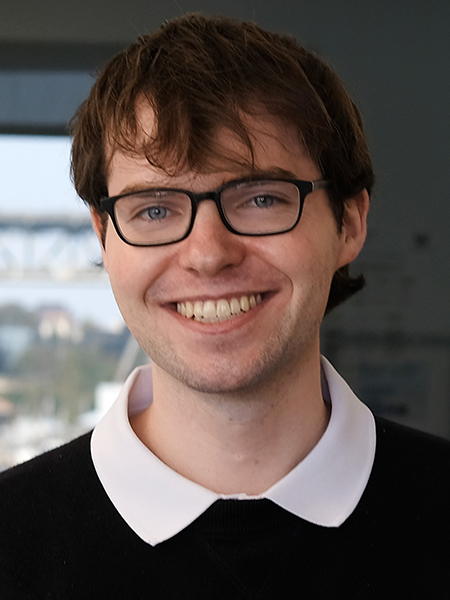The 1939 movie “The Wizard of Oz” opens in black and white. After a tornado sweeps up her Kansas home and drops it with a thud, Dorothy, the story’s protagonist, opens the front door, her dog Toto in tow. When she does, she’s greeted by a world of color.
“Toto, I have a feeling we’re not in Kansas anymore,” she says, eyes wide.
Allen School senior Matt Deitke is not from Kansas, nor has he been to the Land of Oz. Yet he experienced a similar revelation, minus the intervention from Hollywood or Mother Nature. When Deitke was in high school, he spent long hours using Adobe Photoshop to manually colorize images for personal projects. But the task was tedious and unavoidable, he said, a process to be endured rather than enjoyed.
That changed when he encountered a different kind of technical wizardry, one that opened up a new world of color. Via artificial intelligence, the process could be automated. A black-and-white image of a Monarch butterfly, for instance, underwent metamorphosis before his eyes, the orange of its wings bursting into arresting, vibrant life.
“I was completely amazed,” Deitke said. “Witnessing the impressive results, it felt like I was experiencing pure magic.”
Yet the laws behind this trick were governed by logic, not legerdemain. For the budding scientist, neither tornado nor Toto was needed. He wasn’t in “Kansas” anymore.
“This eye-opening experience led me to realize the impact computer vision would have on the field of computer graphics,” he said. “It soon became clear that these AI techniques would transform industries far beyond design.”
While Deitke doesn’t hail from the Sunflower State, he spent his youth in the Midwest, growing up in a suburb of Chicago. There he tinkered with computer graphics, interface design and visualization, completing projects for Ohio State University and the University of Cincinnati while still in high school. The possibilities of AI led him to the University of Washington, where he quickly channeled his curiosity into practice.
His first year brought several new experiences. As a freshman, he enrolled in a graduate computer vision course taught by Richard Szeliski, Steve Seitz and Harpreet Sawhney. At the time, Szeliski was revising his 2010 book “Computer Vision: Algorithms and Applications,” updating it to account for advances in deep learning. Deitke, not one shy to show his inquisitive side, wrote pages of comments to Szeliski on topics such as transformers and text-to-image generation. He asked probing questions, gave insightful suggestions and turned heads.
“At some point I said, ‘Would you be willing to write a section of the book?’” Szeliski said. “He agreed, and there’s a whole chapter on the more advanced topics of deep learning that he wrote.”
Deitke soon went on to author more impressive feats. Early in his time at the Allen School, he began working for The Allen Institute for AI (AI2), a global leader in advancing AI research, and became a full-time employee toward the end of his sophomore year.
“UW is an exceptional place to do AI research,” Deitke said. “Particularly now that AI progress requires a lot of engineering and computational power.”
At AI2, he joined the Perceptual Reasoning and Interaction Research (PRIOR) team, the computer vision research group then led by Allen School professor Ali Farhadi. Now headed by Allen School affiliate associate professor Ani Kembhavi, PRIOR continues to innovate in the AI research space, focusing on vision-and-language research, embodied AI and common good research.
One project Deitke recently completed, ProcTHOR, investigated scaling up the diversity of datasets used to train household robotic agents. He was lead author on the paper, which won an Outstanding Paper Award at the 2022 Neural Information Processing Systems (NeurIPS) Conference.
“Training robots in the real-world is difficult and time consuming,” Deitke said. “An emerging alternative is to train robots in photorealistic video-game simulators to make training much faster.”
Prior to ProcTHOR, artists had to manually design spaces such as simulated 3D houses. Deitke proposed a generative function to sample diverse and realistic house environments. It worked brilliantly.
“Training on the generated houses led to remarkably robust agents across several distributional shifts,” Deitke said. “We’ve still yet to hit a ceiling on how much further such a simple recipe can go.”
As it turns out, there’s no place like home. For Deitke, UW has been home for the past four years. With graduation nearing, he’s been weighing offers from several top doctoral programs, looking to continue his research and keep searching for that spark of “pure magic,” wherever it might be.
“The field of AI is beginning to change the world,” he said. “It is incredibly rewarding being able to work on the cutting-edge of research and pushing the frontier of what’s possible in science and technology.”


